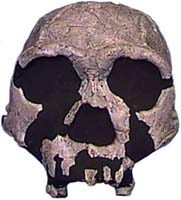Homo ergaster

 One of the most famous finds at Lake Turkana, Northern Kenya
, is the cranium of an early species of Homo, known as
Australopithecus boisei. However, in the same sedimentary layer, another cranium was also found belonging to a species of hominid named Homo ergaster. This hominid species is believed to be a different geographical population of Homo erectus.
One of the most famous finds at Lake Turkana, Northern Kenya
, is the cranium of an early species of Homo, known as
Australopithecus boisei. However, in the same sedimentary layer, another cranium was also found belonging to a species of hominid named Homo ergaster. This hominid species is believed to be a different geographical population of Homo erectus.
Many aspects of Homo ergaster and
Homo erectus anatomy are, of course, similar, with the principal differences being a higher cranial vault, thinner cranial bone, absence of sagittal keel, and certain cranial base characteristics in Homo ergaster. One distinguishing feature between early Homo and ergaster/erectus involves increased brain size (ranging between 850 and 1100 cc, with an increase over time), although the increase in body size actually means that the relative brain size has increased but little.
Other distinguishing features include a long, low cranium (particularly in Homo erectus), the presence of brow ridges, a shortened face, and a projecting nasal aperture, suggesting the first appearance of the typical human external nose with the nostrils facing downward. The structure of the nose would permit the condensation of moisture from exhaled air, which would have proved beneficial in a species that pursued an active subsistence strategy in warm, arid habitats, such as those occupied by early Homo ergaster.
 Early Homo gave rise to a large-bodied, large-brained speices in Africa approximately 2 million years ago, but this species is now called Homo ergaster by many anthropologists. Homo ergaster expanded its range beyond Africa and into Asia soon after its origin and at least by 1.8 million years ago; it then gave rise to Homo erectus in those areas. Homo erectus expanded its range throughout Asia, back into Africa, and presumably into Europe. Approximately 150,000 years ago, a speciation event in Africa gave rise to Homo sapiens (probably from Homo ergaster, but possibly from Homo erectus), which then spread into the rest of the Old World, and subsequently into Australia and the Americas.
Early Homo gave rise to a large-bodied, large-brained speices in Africa approximately 2 million years ago, but this species is now called Homo ergaster by many anthropologists. Homo ergaster expanded its range beyond Africa and into Asia soon after its origin and at least by 1.8 million years ago; it then gave rise to Homo erectus in those areas. Homo erectus expanded its range throughout Asia, back into Africa, and presumably into Europe. Approximately 150,000 years ago, a speciation event in Africa gave rise to Homo sapiens (probably from Homo ergaster, but possibly from Homo erectus), which then spread into the rest of the Old World, and subsequently into Australia and the Americas.
This table shows the main morphological differences between Homo ergaster and Homo erectus.
|
|
Homo ergaster |
Homo erectus |
|
Height |
1.3 � 1.7 metres |
1.3 � 1.7 metres |
|
Physique |
Robust, but "human" skeleton |
Robust, but "human" skeleton |
|
Cranial Volume |
750 � 1250 cc |
750 � 1250 cc |
|
Known Date |
1.8 � 1.2 million years ago |
1.8 � 0.1 million years ago |
|
Distribution |
Africa into Asia |
Africa, Asia and Indonesia (and Europe?) |
|
Skull form |
Higher cranial vault, thinner cranial bone, absence of sagittal keel and certain cranial base characteristics |
Flat, thick skull with large occipital and brow ridge |
|
Jaws/Teeth |
Robust jaw in larger individuals; smaller teeth than H. habilis |
Robust jaw in larger individuals; smaller teeth than H. habilis |
|
Ardipithecus ramidus
|
Australopithecus anamensis
|
Australopithecus afarensis
|
|
Australopithecus africanus
|
Australopithecus aethiopicus
|
Australopithecus boisei
|
|
Australopithecus robustus
|
Homo habilis
|
Homo rudolfensis
|
Homo erectus
|
Homo ergaster
|
|
Homo heidelbergensis
|
Homo neanderthalensis
|
Homo sapiens
|

 One of the most famous finds at Lake Turkana, Northern Kenya
, is the cranium of an early species of Homo, known as
Australopithecus boisei. However, in the same sedimentary layer, another cranium was also found belonging to a species of hominid named Homo ergaster. This hominid species is believed to be a different geographical population of Homo erectus.
One of the most famous finds at Lake Turkana, Northern Kenya
, is the cranium of an early species of Homo, known as
Australopithecus boisei. However, in the same sedimentary layer, another cranium was also found belonging to a species of hominid named Homo ergaster. This hominid species is believed to be a different geographical population of Homo erectus. Early Homo gave rise to a large-bodied, large-brained speices in Africa approximately 2 million years ago, but this species is now called Homo ergaster by many anthropologists. Homo ergaster expanded its range beyond Africa and into Asia soon after its origin and at least by 1.8 million years ago; it then gave rise to Homo erectus in those areas.
Early Homo gave rise to a large-bodied, large-brained speices in Africa approximately 2 million years ago, but this species is now called Homo ergaster by many anthropologists. Homo ergaster expanded its range beyond Africa and into Asia soon after its origin and at least by 1.8 million years ago; it then gave rise to Homo erectus in those areas.